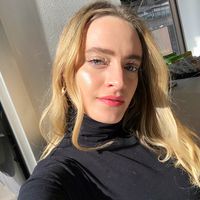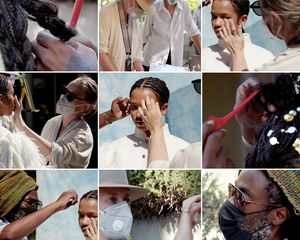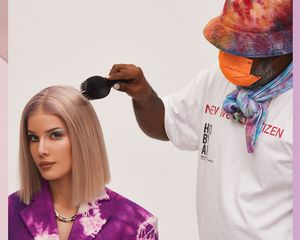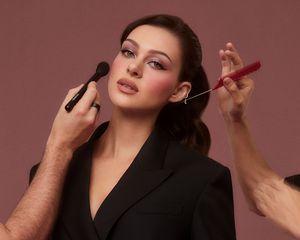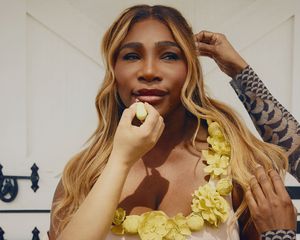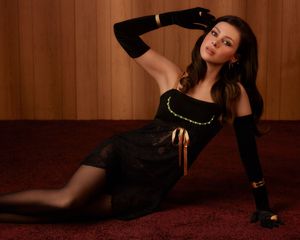Traditionally, the "B-side" refers to the flip-side of a record. The A-side contains the more front-facing hits—the singles—but on the B-side, you can get in a bit deeper with the artist. And quite honestly, there's no better metaphor I can think of for the creative team behind a beauty look. They pull the references, scour the archives, and paint the picture you see on the big screen. The celebrity, model, or actor is the single with the most air time. But the glam team? They're the producers, conductors, friends, and family. For lack of a less ubiquitous phrase, they make it work.
It has always been our mission to shine a light on the BTS of beauty, as the artistry of hair and makeup is an intricate, detailed exploration at the cross-section of aesthetics and culture. Why? Because the origin of a look is just as important as the look itself. The backstory deserves its own hard-earned glory.
This time around, we're introducing you to Ayami Nishimura and Kiyonori Sudo—the masterminds behind the hair and makeup looks for Byrdie's fourth cover—The Power Issue—featuring Jamie Chung. Below, join us in taking a peek behind the curtain with Ayami Nishimura and Kiyonori Sudo, as their beauty musings are thoughtful and powerful in equal measure.
Makeup: Ayami Nishimura
"The inspiration was fun and powerful, with a different color on each eye," Nishimura says of the first look (the jewel-tone creation that ultimately made the cover). "I chose purple and emerald, which is my favorite cool color combination. I added individual lashes on her outer eyes and lots of mascara." The issue's theme, Power, played a huge part in the entire shoot, from concept to execution. Nishimura experimented with textures, colors, and shapes that felt energetic yet potent. And Jamie was an impeccable muse every step of the way. "Jamie was open and excited to try different looks," Nishimura said of Chung's ability to collaborate in the chair. "Plus, she has dream skin. I really enjoyed doing her makeup."

For the second look, we chose to work with eyeliner, but in a fresh, more exciting way. Nishimura went with another asymmetrical design and let her instincts guide her as she applied different colors and shapes to each eye. "I played with colored lines like pink, blue, and white and spontaneously applied them differently on each eye. The look was more modern that way."
Nishimura always knew she wanted to be a makeup artist and, like many of us, fell in love with beauty during her teenage years. "I enjoyed doing my friends' makeup," she told me.
She's most attracted to '70s punk eccentricity, '80s New Romantic flamboyance, and '90s vamp minimalism, which lends itself well to the roots of her makeup career. Nishimura started out in London, working on every single issue of Dazed & Confused magazine (a bi-monthly founded in 1991 rebranded as Dazed in 2008). It was a culture magazine that become a movement, and according to Nishimura, it was the ultimate place to learn and work in her early days. "I had so much fun," she tells me, "fun work and fun shows." Johnnie Sapong, the hairstylist for our first-ever digital issue, spoke of working in London in the '90s with the same reverent nostalgia. London shaped and nurtured so many of beauty's most iconic artists, Nishimura included, and the wistfulness with which she describes that time adds a layer of FOMO I've likely never felt so deeply.
Of her greatest career highlights, Nishimura says publishing a beauty book with British photographer and Dazed & Confused founder, Rankin, tops the list. "Ayami Nishimura by Rankin was published in 2012, and we had an exhibition in London and Tokyo," she tells me, reminiscing, "We had a fantastic opening at Diesel Tokyo Gallery." She loves the research and references that go into the job, too, citing the decades of work she did with Vogue Japan. "I love working on research. It's fun to search, digest, and convert [past trends] to modern looks," Nishimura tells me.

We discuss working with Asian features—something all makeup artists should have experience with and education on, but don't—and Nishimura verbalizes the most important point of all: "We [need to] enjoy the differences in each of us; that's what will give us confidence." She adds, "I am Japanese and I have always loved Asian features. As a makeup artist, flat eyes [offer] more space [to work with], and high cheekbones are beautiful." She says she has noticed a difference in the way Asian features are embraced on set recently, but there's always more work to be done. "Eyes don't need to have deep sockets to be beautiful," she says, adding, "I have been a makeup artist [for decades] and lived in three different countries." That time has allowed Nishimura to work with and appreciate every unique face—and celebrate, embrace, and cherish those differences. "Beauty means authentic confidence," Nishimura says, "[It's something that comes from inside of the person."
"A spring sunset is the inspiration," Nishimura said of the third and final look of the day—and the one I fell in love with instantly on set. "I applied orange on her cheeks and blended it into pink [along her temples, hairline, and forehead]. Then, I added sky blue on her eyes for an unexpected pop. It was beautiful."
Before our time together was up, I asked her for some advice for those looking to break into the industry. She replied, "Keep working on your own ideas. Be ready for the opportunity." It's a lesson we can all draw inspiration from, regardless of industry.
Hair: Kiyonori Sudo
The hair looks this time around were simple: dry and straight, wet and straight, and a sleek, high ponytail. Which, coincidentally, is exactly Sudo's style. "Asian minimalism is beautiful, and it's a strong part of Asian culture," he told me. Sudo knew from the beginning he wanted to use just a few products, "I wanted to do something different with the shape, but keep the hair natural," he said, and decided the exact styles after meeting with Jamie. "She is great—so great," he exclaimed when I asked what it was like to have Chung in his chair. And it's true: She was a master on set; posing with power, playfulness, and a spontaneity that felt entirely refreshing. She had no problem working the hair, either.

Sudo decided he wanted to be a hairstylist when he was in high school in Tokyo, as he saw an inherent white space. "It was so hard to find a hairstylist that felt cool," he says with a laugh. "I wanted to be that cool hairstylist." Similarly, Sudo doesn't name famous mentors or beauty icons when I ask, but tells me he finds inspiration from people on the street. That way, it's never over-worked or painstakingly perfect—it's just, in his words, cool. His advice is simple, just like his hair: "The details are everything," he says. "Keep everything imperfect and maintain [the model's] personality. You can make your own hair philosophy."
In 2002, Sudo traveled the world—from Europe to Asia to the U.S.—and landed back in Japan by 2004 to start his career as a hairstylist. When he moved to New York in 2013, his imaginative aesthetic took the fashion, music, and beauty industry by storm. He calls his style "sophisticated modern," and Sudo was able to develop his craft while assisting famous hairstylists in the industry. Since, he's worked on shoots for Vogue, Harper's Bazaar, Interview, ELLE, New York Magazine, and so many more, as well as for big brands like Adidas, Uniqlo, Nordstrom, and Kenzo. "[Beauty] is my passion and my energy," he says. "It's my meditation." He adds, poetically: "Inner beauty makes you stronger—it's confidence."
When I asked what he thought about representation—if it felt like there was real change happening for Asian Americans in this country, he said, simply, "Yes." He told me, "I can feel it. It's changing." He notes it's true that while Asian culture has become more popular—"movies, music, anime"—and many people respect Asian culture more because of it, there's still more work to be done.

In fact, Sudo spent his time during the pandemic working on a creative outlet meant to unite all of us and create joy through art. He debuted his "Hairtogether" project in June—five hairstyles made from magazine scraps dating back to the early aughts. Working with him on set felt reminiscent of those intentions: quiet brilliance and creative joy. Every brush stroke had a purpose and every spritz felt beautiful. He worked quickly, but thoughtfully, and smiled the entire time. (Not to mention, he looked like a model in our B-Side cover shoot.) It was a pleasure to watch him work.
In his kit, he keeps all the classics: Oribe's Foundation Mist, Bumble and bumble's Thickening Spray, L'Oréal's Elnett Satin Strong Hold Hairspray, as well as his own handmade argan oil and salt-sugar spray. I'm going to need to get my hands on those...
:max_bytes(150000):strip_icc()/landingpage_hero_desktop-13147bc1d9fc4e9a8e4e6a323d6011b3.jpg)
:max_bytes(150000):strip_icc()/B-Sides_recirc-b7dee4e62cad4eaf8c19110ad6a6f3b4.jpg)
:max_bytes(150000):strip_icc()/edit_asian-beauty-noteables-recirc-67113c075a344ddcb74a9b88cff62807.jpg)
:max_bytes(150000):strip_icc()/therapytips-recircsprimary-a8b50ff82888487fb477b07cfc1dc784.jpg)
:max_bytes(150000):strip_icc()/compassionfatigue-recircsprimary-5222a3c16468416fae712fa7823b53a4.jpg)
:max_bytes(150000):strip_icc()/editorspick-recircs-13eb4e9f18ee413db9514e344d7a8968.jpg)
:max_bytes(200000):strip_icc()/The-BSide-SF-85e0dfb0d3e5441eaf0edc0b488af9a0.jpg)
